A sleep system has always been a mainstay in my bug out bag. If you need to overnight somewhere, you will be a lot happier (and a lot more effective the next day) if you can sleep well, especially since we are all used to sleeping on a mattress.
by J. Bridger, contributing writer
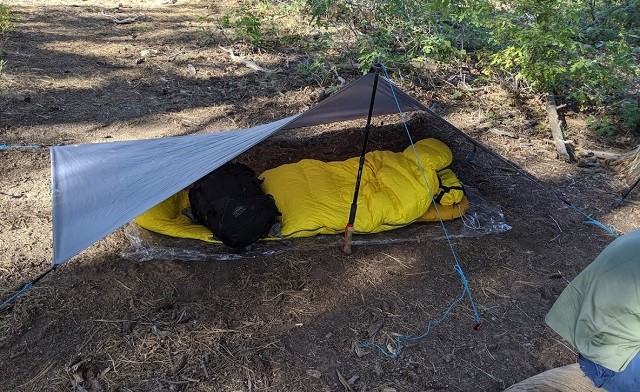
A sleep system doesn’t have to weigh 15 pounds and take up your entire bag. I like to use a blanket or sleeping bag, ground pad, and ground sheet. The pad keeps the ground from sucking heat out of you, and the sheet protects your equipment from the dirt. I tried hammocks but found them to be just as heavy a tents and a little inconvenient. You still need something on your backside, and if you can’t find two trees, you’re SOL. Here I talk about a couple lightweight options that work well for me.
Double Black Diamond Throw – The Perfect Bugout Blanket?
In pursuit of warmer, lighter gear, I have found it gets expensive quickly. I see $300 down quilts all the time on the internet. For outdoor sleeping, I was using a heavy wool blanket. It was warm and tough as can be, but bulky and very heavy. It ate up way too much room in my pack.
Soon after, I graduated to a down sleeping bag made by Wenger. Good to 20 degrees, it weighs in at 2lbs 8oz. It was space age compared to my old wool blanket. It’s a great bag, but I needed something I could use in the spring and summer months. Occasionally, I find something that is an absolute gem. That one item that is good quality, fills a need perfectly, and doesn’t break the bank. Browsing Amazon one day, I came across the Double Black Diamond Down Throw. I couldn’t get it to the checkout line fast enough, and it’s been in my pack ever since.
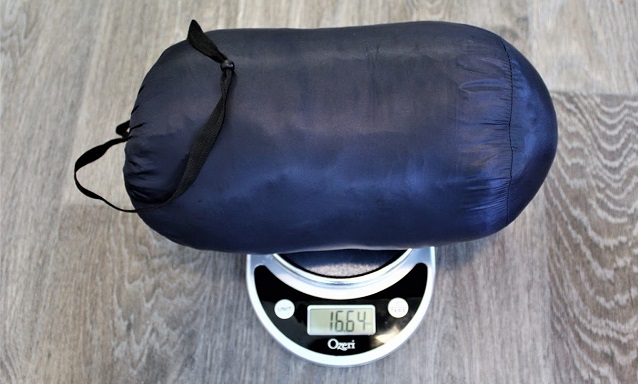
My first impression was that this blanket is warm and light. The shell is made of 20D polyester and nylon and contains 700 fill power down. The website states its size as 60 inches x 70 inches, but mine measured 54 in. x 67in. I bet if I pulled it taut, it would be 60”x70”, but I didn’t measure it that way. It packs down small, about 6”x11”. It doesn’t include a compression sack, which would’ve made this deal even sweeter.
You can buy a cheap compression sack, but the sack it came in works fine. I use it at night as a pillow, stuffed full of clothes or other items. It also packs down and fits perfectly in a 2L dry bag. I leave mine in its own 8L dry bag because I keep it ready to go all the time.
Double Black Diamond Throw Field Test
The first night I used the down throw, I was comfortably warm. It was chilly (in the mid-50s) at about 7,300’ above sea level. One of only two problems I had was this blanket was so light, about any breeze that came through would blow it off my shoulders. Not a huge deal, but it really pissed me off at the time.
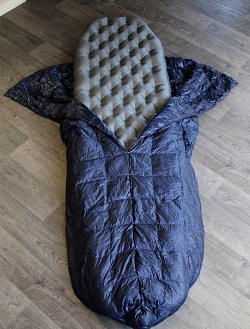
To remedy this, I stitched a toe box into it, resembling a sleeping bag halfway unzipped. The next time I used it (for my Buckskin Gulch trip) it was perfect. I had no problems with it coming off during the night.
For the final test, I did an overnight hike up a rocky valley to some dried-up falls. It was about 8,800’ above sea level, and that night it got down to 45. It was pretty chilly in the wind. I slept in a base layer, socks, and a beanie.
The forecast gave a 50% chance of rain, so I pitched a tarp shelter. The tarp kept the wind off, and it never rained (I’ll bet if I hadn’t pitched a tarp, it would have poured). I never got cold, but I don’t think I would want to test it down any farther. If it’s less than 45, I’ll just bring my sleeping bag.
The only other problem I had, and it’s not a huge issue, but this blanket is slightly short. I’m 5’-9”, and it’s perfect for me. If it was any shorter, it’d be too short. If you’re any taller, it may be too short for you. Many people online have combined two blankets for a loftier, larger quilt. If I had the sewing prowess and the patience, I would do that, but… I don’t. I suspect this would also make a great DIY under quilt for hammock camping.
I really like this blanket for backpacking, especially when I know what the conditions are going to be. This would be a great blanket for children, or to keep in your bugout bag during the summer. In the winter months, I would swap it out for something warmer. It’s cheap enough you could get a couple to keep in your truck.
The only issues keeping this from being the perfect bugout blanket are few. It’s made in China, and it would not offer any warmth if it were wet. The shell seems durable enough, but I would be wary of burning Osage orange near it, it may pop and send a hot ember through the shell. I have washed it in the machine a couple times, but I let it air dry. It hasn’t seemed to hurt it any. The price is right, it’s lightweight, and warm down to the mid-40s for me. They hit a home run with this one.
Double Black Diamond Throw Summary
- Materials: Shell: 20D polyester and nylon. Fill: 700 fill power silver duck down.
- Weight: Mine is 16.64 oz (472 grams) (with stuff sack).
- Packed Size: Approximately 6”x11”
- Actual Size: 54”x67”
- Cost: Around $40
- Pros: Cheap. Warm. Light.
- Cons: May be a bit short for some. Made in China. No compression sack. So light it may blow off at night.
Bug Out Sleeping Pads
Sleeping pads may not be as sexy as ARs or picking handcuffs, but trust me, they are a must-have item for any backpack or bug out bag. If you spend a night on the trail or in a bug out scenario, you will be glad you had the forethought to pack a solid pad. They prevent heat loss from the ground and will give you a better night’s rest. This equates to a better attitude and performance. This goes without saying, but if you carry an inflatable pad, make sure you carry a patch kit.
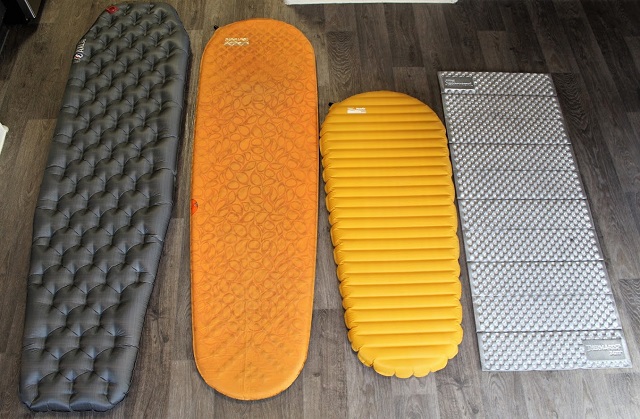
If I had to choose one pad, I’d say it depends on the mission. What’s the weather like? Am I going to use it in my bugout bag? Is it going to live in my truck’s ‘get home bag’ and probably never be used, except on car-camping trips? If you can live with the bulk, the Z-Lite is cheap, warm, and won’t deflate on you. If you can’t, and need a little more comfort, the NEOAir XLite is a proven pad. Sometimes simple is best!
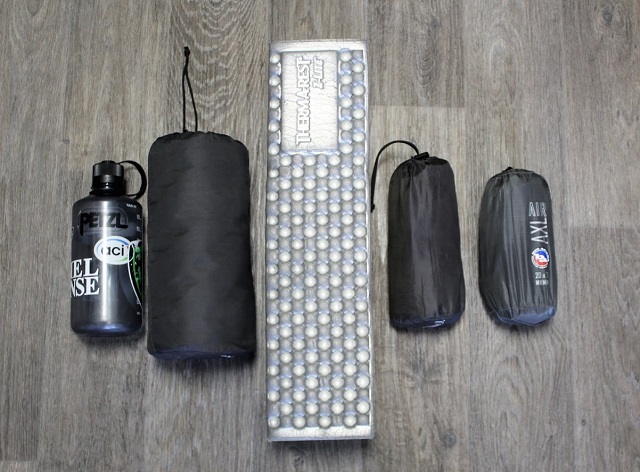
Following is a closer look at the four I have experience with.
Therm-A-Rest Z-Lite
The Therm-a-Rest Z-Lite was my first pad, and I love how simple it is. You don’t have to blow it up, so there’s no chance of a leak. I’ll never have to haul this thing to the nearest river or bathtub to try to find the tiny hole ruining my life. It’s lightning fast to set out and pack up. It doesn’t offer much comfort on hard ground, but it will keep you warm.
My biggest complaint is it’s bulky, so I usually strap it to the outside of my pack. This makes it more susceptible to wear and tear, but it’s handy to whip out to lay down for a quick rest on the trail. I don’t have an under quilt, so if I’m hanging in my hammock, I just use this. It’s soft and pliable enough that it isn’t uncomfortable, and it keeps my back side warm. I got a short one to keep things light, and I don’t regret it. I use my empty pack for my feet to keep my ankles off the ground and my feet warm. Perfect!
- Weight: 9.78 oz (277 grams)
- Packed Dimensions: 5.25”x3.75×20”.
- Dimensions in Use: 20”x51.5” (Approximately 4 ft 3.5 in)
- Breaths to Inflate: Zero
- Pros: Lightweight. Doesn’t require inflating and can’t pop. Quick set up and take down.
- Cons: Bulky, not much comfort on hard ground.
- Cost: Around $25.
Big Agnes AXL Air Mummy
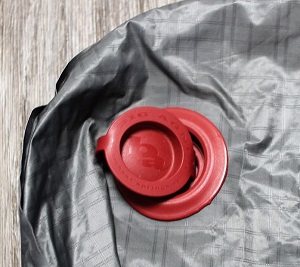
The Big Agnes AXL is super light and easily the most comfortable pad I’ve used. I even like the color. The one-way valve doesn’t let air out between breathes, which is great. If you’re high in elevation, you may have to stop and catch your breath to inflate this pad. It’s as wide as my Z-lite, but for some reason it feels narrower. The material is so light and thin, it can be challenging to fold and roll up in the wind.
Big Agnes (BA) doesn’t report an R-value for this pad, but I have used it on a windy 30 night at 11,000’ above sea level. That was a cold night, and I may have been warmer with an insulated pad, but I still slept well. Since that night was so cold, I stuffed whatever I could between the ground tarp and my pad. My scarf, dirty socks, dry bags, etc. If BA made a 26” wide three-quarter length pad, it would be perfect. BA makes a dry bag that you can use to push air into this pad, which is a clever idea. That may be something you want to consider if you’re looking at this pad.
- Weight: 10.26 oz (292 grams)
- Packed Dimensions: Approximately 3.25”x8”. Slightly smaller than a Nalgene.
- Dimensions in Use: 20”x72”
- Breaths to Inflate: 19 (Your mileage may vary)
- Pros: Lightweight. Thick. Comes with a patch kit.
- Cons: No R value reported. Almost too narrow for me. (For comparison sake, I am 5’-9” tall, and weigh 160). 19 breaths are enough to make me lightheaded.
- Cost: Around $125
Therm-A-Rest NEOAir XLite
This is a very popular choice for people that like the best money can buy. The NeoAir Xlite is a ¾ length pad, so you may want to put your pack under your feet to make up that length. It’s a little loud initially, but this improves with use. It’s very light and packs up small. It has better insulation than the Big Agnex AXL. It’s a little small for me. It’s probably best for petite people or sleepers who aren’t picky.
- Weight: 8.12 oz (230 g)
- Packed Dimensions: Approx. 3”x8.5”
- Dimensions in Use: 45” Long. Widest point is 19”, tapers to 9” at foot end.
- Breaths to Inflate: 12 (Your mileage may vary).
- Pros: Super light-weight. Packs easily. Comfortable. Comes with a patch kit. No holes after about 80 nights of use. R value is 3.8.
- Cons: Crinkly and loud initially. This improves after some use. Valve will let air out between breaths.
- Cost: Around $175
Therm-A-Rest Prolite
For regular use, the Therm-A-Rest Prolite works great. Its weight & stowed size are the main drawbacks. It will keep you warm on a cold night but lacks the comfort of a thicker pad. This is a good pad for car camping. If you’re trying to keep your pack light, this won’t be your first choice.
- Weight: 16.64 oz (472 g)
- Packed Dimensions: Approximately 5”x11”. Slightly larger than a Nalgene.
- Dimensions in Use: 20”x66”
- Breaths to Inflate: 7
- Pros: Full length. Has padding inside. R Value of 3.
- Cons: Weight. Length is unnecessary for the summer. Did not come with a patch kit. Valve will let air out between breaths.
- Cost: Around $90
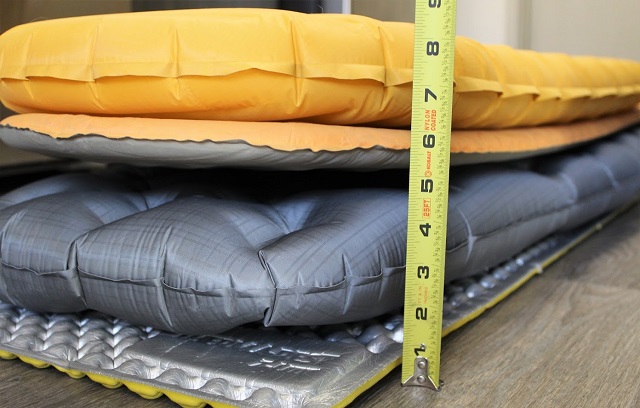
Ground Sheets
Here in the desert, I can get by without a shelter if it doesn’t rain. There aren’t any mosquitoes, and there is no dew. Thank goodness. I never realized how nice it was not to deal with those things. For simplicity’s sake I just use a pad, blanket, and ground sheet. The ground sheet keeps my pad and blanket clean, which will hopefully make them last longer. It’s also more hygienic in a long-term scenario.
Gossamer Gear makes a Polycryo Tent Footprint in medium (40”x96”) and large (72”x96”). These come in a 2 pack for $10. These are super light (Med is 1.6oz, Large is 3.6oz) and surprisingly durable. For the weight and the price, you can’t beat these. If weight isn’t on your mind, it should be. If you disagree, you should throw on your ruck and bust out a 10-mile hike. I didn’t think I would like the fact that they are clear, but I do. I can see if there is a rock or something sharp I’m going to be laying on.
Another option is the blue backpacker’s tarp at WalMart. It’s $10, and I trimmed the grommets and excess size off with scissors. It can fit 2 comfortably and weighs about 6oz. It’s a little more durable. These sheets take up almost no room in my pack, and they don’t break the bank. I wish everything was that simple.
For less than two pounds of weight, I can be comfortable down to 45 degrees. That keeps me safe and gives me the ability to cover a lot of ground without being exhausted. I’ve done 20 miles in a day with this in my pack, all over 8,000’. It sucks, but I can do it.
Lightweight Sleeping Bug Out Summary
If your pack is too heavy you risk exhaustion, injury, and being slow and ineffective. Slow and ineffective is just that – slow and ineffective.
What sleep system do you keep in your bug out bag?
